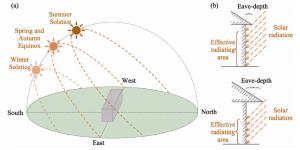Ancient architecture redesigned by cold: climate’s hidden hand
GA, UNITED STATES, August 16, 2025 /EINPresswire.com/ -- In a new study, researchers unravel the long-standing “Six Dynasties Bracket Mystery”—the abrupt decline of projecting arms in ancient Chinese bracket sets—by linking the shift to climate change. Drawing on around 250 archaeological cases and paleoclimate data, the team shows that extreme cooling and drying between the 3rd and 6th centuries prompted a major design shift: shorter eaves for greater solar exposure. This functional response, long interpreted through the lens of aesthetics or craftsmanship, recasts ancient Chinese architecture as a dynamic system finely tuned to environmental stress. The findings offer a rare, data-driven look at how ancient societies physically adapted to climate shocks.
From Mayan droughts to Norse abandonments, climate change has influenced the course of civilizations on multiple occasions. Less understood, however, is how such shifts alter daily life—like the roofs above our heads. In China, ancient buildings constructed with wood and earth were tightly coupled to their environment. Bracket sets, or dougong, supported deep eaves that protected against sun and rain. But during the turbulent 3rd–6th centuries, a key architectural element—projecting arms—nearly vanished from records. Scholars have long speculated about artistic or technological reasons. But given the era's intense climate instability, a deeper investigation into environmental drivers was warranted.
A research team from the Chinese Academy of Sciences and the Chinese Academy of Social Sciences has traced an ancient architectural mystery back to climate change. Their study (DOI: 10.1007/s11442-025-2368-6), published in the Journal of Geographical Sciences in June 2025, provides the first quantitative explanation for the sudden decline of projecting arms in Chinese bracket sets during the 3rd–6th centuries. By combining archaeological surveys, paleoclimate reconstructions, and solar radiation simulations, the team uncovers how builders adapted their designs to shifting climate demands—solving a mystery that has puzzled architectural historians for decades.
To decode the architectural enigma, the team examined nearly 250 quasi-architectural artifacts spanning the 1st to 8th centuries, categorizing them into five stages. Their data showed dramatic drops in the presence of projecting arms during two cold and dry phases—220–317 AD and 439–550 AD. These climate downturns, confirmed by multiple paleoclimate records, reduced rainfall and chilled winters, making deep eaves less useful for rain protection and more of a hindrance to winter sunlight.
Using an idealized solar exposure model, the researchers demonstrated that reducing the eave-depth by removing projecting arms could boost sunlight on building walls by up to 35% in winter—enhancing passive heating. The changes were not random: statistical tests showed the timing of architectural shifts closely tracked climate fluctuations. The bracket sets' decline was not about style, but survival—a calculated adaptation to colder, drier conditions. When the climate warmed again, projecting arms returned. These findings not only solve a long-standing puzzle but also to some extent reframe ancient Chinese architecture as a responsive, climate-adaptive system rooted in functional logic.
“This isn't just a story about lost craftsmanship—it's a story of climate resilience,” said Dr. Li Siyang, first author and researcher in climate archaeology, focusing on past human responses. “Our ancestors weren't passive victims of climate—they engineered their way through it. The bracket sets were more than decorative; they were tools of survival, optimized for warmth, light, and protection. By decoding their logic, we gain a deeper understanding of how design can meet environmental demands.”
As climate change intensifies, ancient strategies offer fresh inspiration. The bracket-set redesigns of historic China mirror modern goals of sustainable architecture—adapting form to local climate. Passive heating via solar-oriented design, once born of necessity, now aligns with carbon-neutral ambitions. These historical insights dovetail with China's “Beautiful China Initiative” and its 2060 carbon neutrality pledge. By blending traditional wisdom with modern technology, architects can create climate-responsive buildings that are both efficient and resilient. This study shows that history is not just something we study—but something we can build upon.
DOI
10.1007/s11442-025-2368-6
Original Source URL
https://doi.org/10.1007/s11442-025-2368-6
Funding information
The Postdoctoral Program of the Institute of Geographic Sciences and Natural Resources Research, Chinese Academy of Sciences
Lucy Wang
BioDesign Research
email us here
Legal Disclaimer:
EIN Presswire provides this news content "as is" without warranty of any kind. We do not accept any responsibility or liability for the accuracy, content, images, videos, licenses, completeness, legality, or reliability of the information contained in this article. If you have any complaints or copyright issues related to this article, kindly contact the author above.
Studycat expands accent‑rich voice training for young learners in children Spanish language Android app
Resource Design & Build, LLC Completes Renovation at 6477 Old Shadburn Ferry Road
Naples Soccer Academy Welcomes Peter Giannopoulos as Director of Security
Więcej ważnych informacji
 Jedynka Newserii
Jedynka Newserii

 Jedynka Newserii
Jedynka Newserii

Konsument

Polacy nie korzystają z hossy trwającej na warszawskiej giełdzie. Na wzrostach zarabiają głównie inwestorzy zagraniczni
Od października 2022 roku na rynkach akcji trwa hossa, nie omija ona także warszawskiej giełdy. Mimo to inwestorzy indywidualni odpowiadają zaledwie za kilkanaście procent inwestycji, a o wzrostach decyduje i na nich zarabia głównie kapitał z zagranicy. Widać to również po napływach i odpływach do i z funduszy inwestycyjnych. Zdaniem Tomasza Koraba, prezesa EQUES Investment TFI, do przekonania Polaków do inwestowania na rodzimej giełdzie potrzeba zysków z akcji, informacji o tych zyskach docierającej do konsumentów oraz czasu.
Polityka
Obowiązek zapełniania magazynów gazu w UE przed sezonem zimowym ma zapewnić bezpieczeństwo dostaw. Wpłynie też na stabilizację cen

Unia Europejska przedłuży przepisy z 2022 roku dotyczące magazynowania gazu. Będą one obowiązywać do końca 2027 roku. Zobowiązują one państwa członkowskie do osiągnięcia określonego poziomu zapełnienia magazynów gazu przed sezonem zimowym. Magazyny gazu pokrywają 30 proc. zapotrzebowania Unii Europejskiej na niego w miesiącach zimowych. Nowe unijne przepisy mają zapewnić stabilne i przystępne cenowo dostawy.
Infrastruktura
Gminy zwlekają z uchwaleniem planów ogólnych zagospodarowania przestrzennego. Może to spowodować przesunięcie terminu ich wejścia w życie

Reforma systemu planowania i zagospodarowania przestrzennego rozpoczęła się we wrześniu 2023 roku wraz z wejściem w życie większości przepisów nowelizacji ustawy z 27 marca 2003 roku. Uwzględniono w niej plany ogólne gminy (POG) – nowe dokumenty planistyczne, za których przygotowanie mają odpowiadać samorządy. Rada Ministrów w kwietniu br. uchwaliła jednak ustawę o zmianie ustawy z 7 lipca 2023 roku, a jej celem jest zmiana terminu obowiązywania studiów uwarunkowań i kierunków zagospodarowania przestrzennego gmin na 30 czerwca 2026 roku. Wskazana data może nie być ostateczna z uwagi na to, że żadna z gmin nie uchwaliła jeszcze POG.
Partner serwisu
Szkolenia

Akademia Newserii
Akademia Newserii to projekt, w ramach którego najlepsi polscy dziennikarze biznesowi, giełdowi oraz lifestylowi, a także szkoleniowcy z wieloletnim doświadczeniem dzielą się swoją wiedzą nt. pracy z mediami.









.gif)

 |
| |
| |
|